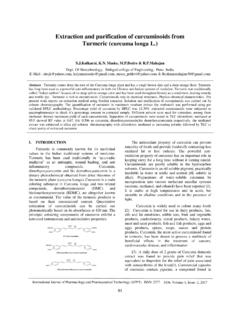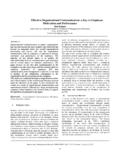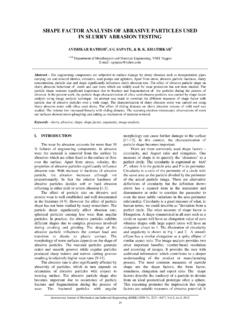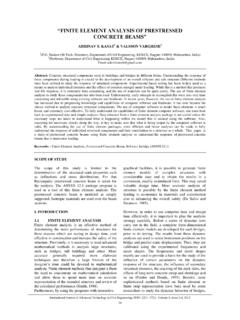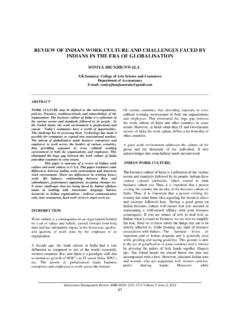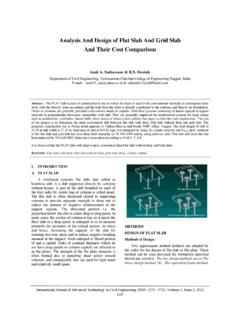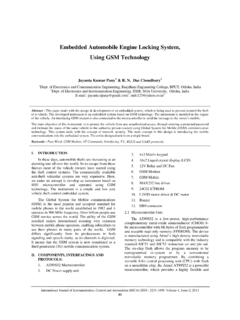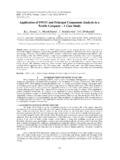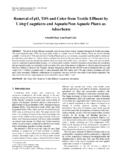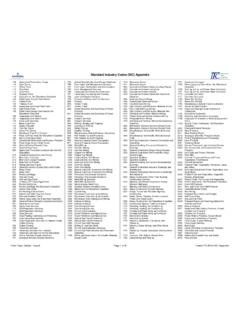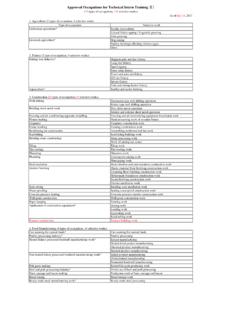Transcription of ENERGY MANAGEMENT IN TEXTILE INDUSTRY
1 International Journal of Power System Operation and ENERGY MANAGEMENT ISSN (PRINT): 2231 4407, Volume-2, Issue-1,2 45 ENERGY MANAGEMENT IN TEXTILE INDUSTRY SARITA SHARMA Department of fashion Technology, International College for Girls, Jaipur, India E-mail : Abstract- ENERGY is one of the most important ingredients in any industrial activity. The availability is not infinite however. ENERGY crisis globally, as well as high cost of fuels resulted in more activities to conserve ENERGY to maximum extent. ENERGY crisis globally, as well as high cost of fuels resulted in more activities to conserve ENERGY to maximum extent. The TEXTILE INDUSTRY is one of the major ENERGY consuming industries and retains a record of the lowest efficiency in ENERGY utilization.
2 About 23% ENERGY is consumed in weaving, 34% in spinning, 38% in chemical processing and another 5% for miscellaneous purposes. In general, ENERGY in the TEXTILE INDUSTRY is mostly used in the form of: electricity, as a common power source for machinery, cooling & temperature control system, lighting, equipment etc.; oil as a full for boilers which generate steam, liquefied petroleum gas, coal. And this has made pathway to conservation of ENERGY which can be affected through process and machinery modifications and implementation of technological advancements relating to process optimization as well as development of newer methods to meet the challenge of substantial ENERGY saving in TEXTILE wet processing.
3 Keywords TEXTILE INDUSTRY , spinning, electricity, wet processing. I. INTRODUCTION The conservation of ENERGY is an essential step we can all take towards overcoming the mounting problems of the worldwide ENERGY crisis and environmental degradation. In particular, developing countries are interested to increase their awareness on the inefficient power generation and ENERGY usage in their countries. However, usually only limited information sources on the rational use of ENERGY are available. The rational use of ENERGY calls for a broad application of ENERGY conservation technologies in the various industrial sectors where ENERGY is wasted.
4 One of these ENERGY intensive industrial sectors to be considered to improve efficiency through the introduction of modern ENERGY conservation technologies is the TEXTILE INDUSTRY . The TEXTILE INDUSTRY is one of the major ENERGY consuming industries and retains a record of the lowest efficiency in ENERGY utilization. About 23% ENERGY is consumed in weaving, 34% in spinning, 38% in chemical processing and another 5% for miscellaneous purposes. The need of ENERGY MANAGEMENT has assumed paramount importance due to the rapid growth of process industries causing substantial ENERGY consumptions in TEXTILE operations.
5 Conservation of ENERGY can be affected through process and machine modification, new technologies and proper chemical recipes. The possibilities of utilizing new ENERGY resources are yet to be explored. These ENERGY resources are solar ENERGY , tidal power, wind power, nuclear ENERGY , etc. But initial cost of production will increase in step with cost of oil, which makes development of such sources doubtful in terms of cost incurred. II. TYPES OF ENERGY USED IN THE TEXTILE INDUSTRY In general, ENERGY in the TEXTILE INDUSTRY is mostly used in the forms of: electricity, as a common power source for machinery, cooling and temperature control systems, lighting, office equipment, etc.
6 ; oil as a fuel for boilers which generate steam; liquefied petroleum gas; coal; and city gas. Table 1 ENERGY Consumption Share of Each Specialized Technical Field in the TEXTILE INDUSTRY Specialized Technical Field Fuel Electri-city Total Share% Fiber production 32,551 21,498 54,049 Spinning 3,224 44,262 47,480 Twisting 219 1,660 1,879 Textured-yarn production 120 1,543 1,663 Weaving 4,467 24,848 29,315 Knitting 4,059 11,709 15,858 Dyeing 37,661 28,412 66,073 Clothing manufacturing 8,240 15,420 23,660 Others 5,959 12,000 17,959 Total 96,500 161,442 257,942 Unit: million Rs. ENERGY MANAGEMENT in TEXTILE INDUSTRY International Journal of Power System Operation and ENERGY MANAGEMENT ISSN (PRINT): 2231 4407, Volume-2, Issue-1,2 46 Note: Calculated from the Tabulated Industrial Statistics ( INDUSTRY Volume).
7 Table 2 Types of ENERGY Sources Used in the TEXTILE INDUSTRY Note: Calculated from the Annual Report on TEXTILE Statistics. Dyeing represents the dyeing process including finishing, for both woven and knitted materials . III. FOCUS AREAS FOR ENERGY CONSERVATION 1. THERMAL ENERGY Thermal ENERGY is major for chemical processing while power dominates consumption pattern in spinning/weaving. Thermal ENERGY in TEXTILE mills is mainly consumed in two operations. They are heating of water and drying of water. The following table indicates the department wise percent steam consumption in a composite TEXTILE mill Thermal ENERGY in the form of steam is supplied to the various equipments through pipe.
8 The average steam consumption in unit operations and stages of wet processing are seen in the following table. Table-II Sr. No Dyeing process Steam consumption in Kg / Kg of fabric 1 Dyeing in jigger or winches 2 Dyeing in dyeing machine 5 3 Pad dry steam 8 dyeing 4 Pad - dry cure/thermo sole dyeing 5 2. ELECTRICAL ENERGY The wet processing of textiles consumes around 15% of the total electrical ENERGY mainly only for running the various processing machineries. Most of the TEXTILE mills draw their power requirements from their respective state electricity boards. Sometimes this has an adverse effect resulting in severe power cuts for the INDUSTRY .
9 Due to this reason, several mills have opted for their own captive generation in spite of higher costs. By taking the advantage of tail race low pressure steam, some mills have tried for turbines. However, their use is limited due to non-availability of low to medium turbines and their maintenance as compared to diesel engines. IV. ENERGY CONSERVATION IN TEXTILE INDUSTRY For fuel conservation, some of the measures are mentioned below. 1. Human factor MANAGEMENT . 2. Fuel selection. 3. Fuel handling and storage. 4. Fuel combustion. 5. Steam generation. 6. Steam distribution. 7. Steam utilization. 8. Maintenance of machine.
10 9. Waste heat recovery. 10. Alternate sources of fuel. 11. Renovation / replacement of existing plants. 12. Process modification Some measures from the dyer s approach are mentioned below. 1. ELECTRICAL ENERGY The main usage of electrical ENERGY in the TEXTILE INDUSTRY is in the manufacture of yam and cloth, amounting to nearly 3/4th or 4/5th of the total power requirement in a TEXTILE mill, where as hardly 15 to 20% of electrical power is consumed for running various machines in TEXTILE wet processing. 1. One bath bleaching may enable to save around 70% electrical inputs. 2. Reduced number of ends / turns jiggers may help in saving around 20% electrical inputs.
